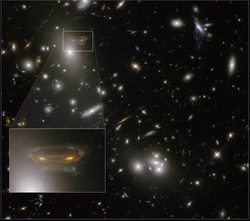This is Scientific American 60 Secomds, Space. I'm Clara Moskowitz, got a minute?
这里是科学美国人60秒,太空系列。我是克拉拉·莫斯科维兹。
Dark matter is that mysterious stuff that apparently accounts for some quarter of the mass and energy in the universe. And for one small wannabe-galaxy, dark matter may have been a lifesaver.
暗物质是一种占宇宙构成近四分之一的神秘物质。对于自封的银河系来说,暗物质就像是一名“救生员”
It's called the Smith Cloud. Astronomers think it's a failed dwarf galaxy that lacked the requisite mass to produce stars. Many millions of years ago the cloud seems to have collided with the Milky Way and passedthrough the disk of our galaxy. A new computer simulation finds that the cloud should have been ripped to shreds. That it survived is evidence that it's protected—by a shell of dark matter.
这种暗物质云叫做“史密斯云”。天文学家认为它由于未达到足够的质量而无法形成恒星。几百万年以前,“史密斯云”已经与银河系撞击过数次,并穿过了银河系的磁盘。通过新的计算机模拟,科学家发现,在于银河系的“亲密接触”后,暗物质星系云本应该被撞成碎片。星系云得以保留完整恰恰证明了暗物质壳层具有保护作用。

The report will appear in the journal Monthly Notices of the Royal Astronomical Society.
该报告发布在“皇家天文学会月报”杂志中。
That dark matter shell could have insulated the Smith Cloud from the Milky Way's gravitational forces, which otherwise should have torn Smith apart.
暗物质曾可能阻止了银河系对“史密斯云”的引力作用,否则,它会被撞成碎片的。
As if its first fender-bender with the Milky Way wasn't enough, the Smith Cloud is coming back for more. It's on course to slam into our galaxy again—in about 30 million years. Perhaps future astronomers will note whether its dark matter shroud once again saves the cloud.
似乎“史密斯云”认为第一次与银河系的撞击还不够“刺激”,现在它又要再一次与银河系“亲密接触”。三千万年来,撞击“银河系”似乎已经成了行程安排的一部分。也许,未来的科学家就可以确定是不是壳层保护了暗物质云免受撞击带来的伤害了。
Thanks for the minute for Scientific American 60 Secomds, Tech. I'm Clara Moskowitz.












